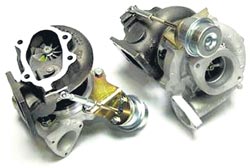
Your turbo should be compatibleNowhere in the world of engine building is finding correct compatibility more important than with turbochargers. A correctly matched turbo can add more power to your engine than any other single modification. Installing the wrong turbocharger can make your car a high-strung mess, a choked torque machine, or even contribute to serious engine damage. Fortunately for us, a turbocharger is a cold, hard, unthinking machine, so the job of making a good match for your engine is a relatively simple one. Choosing the right compressor (that's the intake side of the turbo that compresses that intake air) is probably the most critical step in selecting which turbo you should use. Compressor matching to the engine is also where most beginner mistakes are made. By using the formula we will soon discuss and looking at various compressor maps, you will be able to closely estimate which compressor will work the best for your intended use.
The math involved in choosing the correct turbocharger can be reduced to simple algebra while still retaining enough accuracy to make good matching choices. Matching also requires that the manufacturer publishes some important data, the most important bit being the compressor map. Compressor maps are available from Turbonetics, Innovative Turbo Systems, and Garrett Engine Boosting Systems. The compressor map is a graph of the compressor's efficiency plotted against boost (expressed as pressure ratio on the Y-axis) and the mass airflow (expressed as pounds of air per minute on the X-axis). The compressor map is two-dimensional and reads like a topographical map, but with the islands representing compressor efficiency rather than altitude. Bisecting the islands moving from left to right across the map are the speed lines. These show the rotating speed of the compressor/turbine as expressed by RPM. But what is compressor efficiency? When air is compressed, it gets hotter. That's just physics and there's nothing you can do about it. But ideally, it only has to get as hot as the ideal gas law (PV=nRT) says. When we speak about compressor efficiency, we are referring to adiabatic efficiency or how much hotter air gets than it has to by law. The thermodynamically impossible nirvana of 100% efficiency would mean the compressor discharge temperature was perfectly predicted by the ideal gas law. Less than 100% efficiency means that the compressed air is hotter. Nissan twin ball bearing hybrid ceramic turbos The compressor map also has an important landmark, the surge line. The area of compressor surge is a line bordering the islands on the far left side of the map. Surge is when the air pressure after the compressor is higher than the compressor can generate. This causes the airflow in the compressor wheel to back up and stall. This, in turn, causes the pressure to drop, allowing flow to resume until it stalls again. In severe surge this can become a violent oscillation that destroys the thrust bearing of the turbo and can even cause mechanical failure of the wheel. Surge can feel like anything from a slight fall off in power to a violent jerking when driving. Surge also makes a thrumming or chirping noise that can be distinctly heard over the engine. You'll often hear compressor surge during shifts, if the compressor bypass valve (or blow-off valve) is too small. Obviously surging any time other than during a shift is not good stuff, so any compressor match should avoid crossing over or dwelling in the surge area of the map especially after the wastegate opens. Well that's it for this episode feel free to e-mail me with your questions on plasmaim@yahoo.com and I will do my very best to answer your queries. |
|| Front
Page | News | Editorial | Columns | Sports | Plus | Financial
Times | International | Mirror | TV
Times | Funday
Times | ST1 || |
| |
Copyright
2007 Wijeya
Newspapers Ltd.Colombo. Sri Lanka. |
